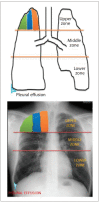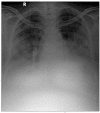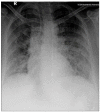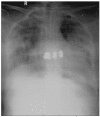Role of chest radiograph in predicting the need for ventilator support in COVID-19 patients
- PMID: 36798522
- PMCID: PMC9923502
- DOI: 10.7196/AJTCCM.2022.v28i4.248
Role of chest radiograph in predicting the need for ventilator support in COVID-19 patients
Abstract
Background: COVID-19 disease, a pandemic for more than two years, has major morbidity and mortality related to pulmonary involvement. Chest radiography is the main imaging tool for critically ill patients. As the availability of arterial blood gas analysis is limited in the Level I and II healthcare centres, which are major partners in providing healthcare in resource-limited times, we planned the present study.
Objectives: To assess the role of chest radiography in predicting the need for oxygen/ventilator support in critically ill COVID-19 patients.
Methods: This hospital-based, retrospective study included 135 patients who needed oxygen/ventilator support and had optimal-quality chest radiographs at admission. All the chest X-rays were evaluated and a severity score was calculated on a predesigned pro forma. Statistical evaluation of the data obtained was done using appropriate tools and methods.
Results: Males outnumbered females, with a mean age of 54.35 ± 14.49 years. More than 72% of patients included in our study needed ventilator support while the rest needed oxygen support. There was a significant statistical correlation between the chest radiograph severity score and SPO2 /PaO2 levels in our study. Using a cut-off value >8 for the chest radiograph severity score in predicting the need for ventilator support in a Covid-19 patient, the sensitivity, specificity and accuracy was 85.7%, 92.5% and 89.5%, respectively.
Conclusion: Chest radiography remains the mainstay of imaging in critically ill COVID-19 patients when they are on multiple life-support systems. Though arterial blood gas analysis is the gold standard tool for assessing the need for oxygen/ventilator support in these patients, the severity score obtained from the initial chest radiograph at the time of admission may also be used as a screening tool. Chest radiography may predict the need for oxygen/ventilator support, allowing time for patients to be moved to an appropriate-level healthcare centre, thus limiting morbidity and mortality.
Keywords: COVID-19; Chest radiography; ventilator.
Conflict of interest statement
Conflicts of interest: None.
Figures








Similar articles
-
Chest X-ray Severity Score as a Putative Predictor of Clinical Outcome in Hospitalized Patients: An Experience From a Vietnamese COVID-19 Field Hospital.Cureus. 2022 Mar 19;14(3):e23323. doi: 10.7759/cureus.23323. eCollection 2022 Mar. Cureus. 2022. PMID: 35464539 Free PMC article.
-
Safety and Efficacy of Imatinib for Hospitalized Adults with COVID-19: A structured summary of a study protocol for a randomised controlled trial.Trials. 2020 Oct 28;21(1):897. doi: 10.1186/s13063-020-04819-9. Trials. 2020. PMID: 33115543 Free PMC article.
-
Chest X-ray for predicting mortality and the need for ventilatory support in COVID-19 patients presenting to the emergency department.Eur Radiol. 2021 Apr;31(4):1999-2012. doi: 10.1007/s00330-020-07270-1. Epub 2020 Oct 8. Eur Radiol. 2021. PMID: 33033861 Free PMC article.
-
Diagnostic Accuracy of Chest Radiograph, and When Concomitantly Studied Lung Ultrasound, in Critically Ill Patients With Respiratory Symptoms: A Systematic Review and Meta-Analysis.Crit Care Med. 2018 Jul;46(7):e707-e714. doi: 10.1097/CCM.0000000000003129. Crit Care Med. 2018. PMID: 29601314
-
Thoracic imaging tests for the diagnosis of COVID-19.Cochrane Database Syst Rev. 2020 Nov 26;11:CD013639. doi: 10.1002/14651858.CD013639.pub3. Cochrane Database Syst Rev. 2020. Update in: Cochrane Database Syst Rev. 2021 Mar 16;3:CD013639. doi: 10.1002/14651858.CD013639.pub4. PMID: 33242342 Updated.
Cited by
-
Lung Ultrasound Score in COVID-19 Patients Correlates with PO2/FiO2, Intubation Rates, and Mortality.West J Emerg Med. 2024 Jan;25(1):28-39. doi: 10.5811/westjem.59975. West J Emerg Med. 2024. PMID: 38205982 Free PMC article.
-
Still a role for the chest radiograph - humble but helpful!Afr J Thorac Crit Care Med. 2022 Dec 19;28(4):10.7196/AJTCCM.2022.v28i4.300. doi: 10.7196/AJTCCM.2022.v28i4.300. eCollection 2022. Afr J Thorac Crit Care Med. 2022. PMID: 36895778 Free PMC article. No abstract available.
-
Differential Radiographic Chest Findings in COVID-19 Positive Patients with and Without Comorbidities.Adv Biomed Res. 2023 May 30;12:143. doi: 10.4103/abr.abr_116_22. eCollection 2023. Adv Biomed Res. 2023. PMID: 37434929 Free PMC article.
References
-
- Salehi S, Abedi A, Balakrishnan S, Gholamrezanezhad A. Coronavirus disease 2019 (COVID-19): A systematic review of imaging findings in 919 patients. Am J Roentgenol. 2020;1:1–7. - PubMed
LinkOut - more resources
Full Text Sources
Research Materials
